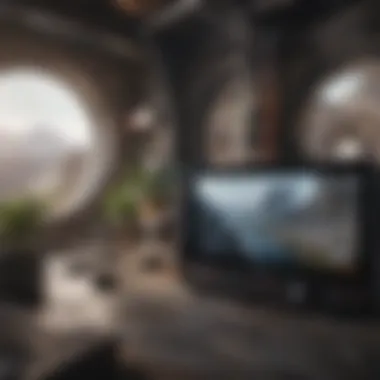Infotainment's Impact on Scientific Communication


Intro
The integration of infotainment in scientific communication represents a significant shift in how scientific information is disseminated to the public. In recent years, platforms such as BioCascades have emerged, blending educational content with engaging formats that appeal to a broader audience. This trend emphasizes the need for effective science communication strategies that not only convey complex ideas but also capture the interest of diverse groups.
Infotainment, a combination of information and entertainment, is changing the landscape of how people consume scientific knowledge. By utilizing storytelling, visual aids, and interactive elements, infotainment fosters a more approachable and relatable atmosphere for learning. This article delves into the nuances of coloring scientific dialogue with infotainment elements, ensuring the accuracy and significance of these communications remain intact.
Prologue to Infotainment in Science
In today's digital age, the fusion of information and entertainment, commonly referred to as infotainment, plays a significant role in how scientific communication is approached. With the rise of various online platforms and social media channels, the methods of disseminating scientific knowledge have transformed. This section lays the groundwork for understanding the scope and impact of infotainment in science. It examines not only its definition but also the historical evolution and current significance in engaging broad audiences.
Defining Infotainment
Infotainment refers to the integration of information with entertainment, aiming to make educational content more appealing and easier to digest. In the context of science, this approach seeks to present complex scientific ideas through engaging narratives, visuals, and interactive elements. This combination can enhance understanding and retention, potentially bridging the gap between scientific communities and the public. By rendering scientific findings in a more user-friendly format, infotainment can attract those who might otherwise dismiss scientific discourse as inaccessible or overly technical.
Historical Context
The concept of infotainment is not new. Historically, the term has been used in journalism and media since the late 20th century. However, its application in scientific communication has gained momentum with advancements in technology. The 1960s and 1970s saw scientists begin to engage with media to popularize their work. Notable examples include television shows dedicated to science, such as "The Cosmos" with Carl Sagan, which sparked interest among millions. The internet has since revolutionized these efforts, providing diverse platforms like YouTube or podcasts, where scientific topics can be debated and discussed in engaging formats.
The Evolution of Scientific Communication
As society progresses, so too does the way scientific knowledge is communicated. In the past, peer-reviewed journals and formal presentations were the primary means of sharing research. This often alienated lay audiences who found the jargon and technical language daunting. However, the advent of infotainment has catalyzed a shift towards more accessible formats. Today, researchers are increasingly utilizing blogs, infographics, and even social media threads to convey their findings. With tools like BioCascades, complex topics can be distilled into engaging formats, allowing for better public understanding and involvement in scientific discourse. Consequently, this evolution reflects a broader societal commitment to science literacy and public engagement.
The Role of Online Platforms in Informing the Public
Online platforms have revolutionized how scientific information is conveyed to the public. These platforms serve as critical venues for sharing knowledge, fostering communication, and enhancing public understanding of complex scientific issues. The ease of access to information through various online channels has transformed the dynamics of science communication. Researchers and educators have a direct line to their audience, allowing for immediate feedback and engagement. This interaction is essential since it creates a sense of community and shared discovery around scientific topics.
Moreover, online platforms facilitate the dissemination of accurate information and can counteract misinformation. With the rise of social media and educational websites, there is a vast potential to reach diverse demographics, including students, educators, policymakers, and the general public. The importance of these platforms cannot be overstated; they shape public discourse on science and influence how scientific knowledge is perceived and utilized.
"Digital platforms are not just a means of broadcasting; they are the new gathering places for scientific dialogue."
BioCascades as a Case Study
BioCascades exemplifies how online platforms can effectively communicate scientific information. This platform integrates influences from biotechnology and environmental science, making complex topics accessible. BioCascades offers multimedia content that includes videos, articles, and interactive graphics. This variety of formats caters to different learning styles and preferences, ensuring engagement from a broad audience.
What sets BioCascades apart is its focus on real-world applications of scientific research. By providing case studies and practical examples, it connects scientific concepts with everyday life. This approach not only enhances understanding but also underscores the relevance of science in solving contemporary issues. Case studies like the bioremediation of oil spills demonstrate tangible solutions provided by scientific advancements, inspiring interest and promoting deeper inquiry into the field.
The Balance Between Complexity and Accessibility
One of the significant challenges of scientific communication is achieving a balance between presenting complex ideas and ensuring that the content remains accessible. Online platforms play a pivotal role in this dynamic. They can employ various strategies to distill complicated scientific principles into understandable segments without sacrificing depth.
For instance, using straightforward language, visual aids, and relatable analogies helps bridge the gap between experts and laypersons. However, care must be taken to maintain scientific integrity. Oversimplifying concepts can lead to misinterpretations, which can ultimately diminish public trust in science.
Effective communication also involves considering the audience's baseline knowledge. Assessing the level of understanding of different groups allows platforms to tailor the complexity of information. This method can enhance knowledge retention and encourage ongoing engagement with scientific content.


In summary, the role of online platforms in scientific communication is paramount. They not only widen the reach of scientific knowledge but also engage and inform a diverse audience effectively. By studying case examples like BioCascades and strategizing around the balance of complexity and accessibility, science communicators can optimize their approach and better serve the community.
Audience Engagement and Relevance
In the context of scientific communication, audience engagement and relevance are integral to the successful transfer of knowledge. Engaging an audience is not simply about attracting attention; it involves fostering a meaningful connection between the content and its recipients. This becomes crucial when discussing complex scientific topics which often require a thoughtful approach to ensure that the target audience comprehends the material. In today’s fast-paced digital world, where misinformation can spread rapidly, ensuring relevancy is equally important. The right approach to audience engagement can make scientific content more accessible, thereby enhancing public understanding of research and its implications.
Diverse Audience Needs
The landscape of information consumption is diverse. Audiences vary greatly in their background knowledge, interests, and reasons for seeking scientific information. Understanding these differences is fundamental for content creators.
- Varied Knowledge Levels: Some individuals may have a strong foundation in scientific principles, while others may only have a cursory awareness. Infotainment must cater to both ends.
- Interests and Motivations: Different audiences might seek out scientific information for various reasons—academic purposes, personal interest, or public policy. Tailoring content encourages engagement.
- Accessibility: Not everyone has easy access to scientific literature. Infotainment aids in bridging this gap.
It is essential for communicators to develop materials that consider these diverse needs. This might involve varying the depth of information presented or utilizing different formats, such as videos or articles, to accommodate different learning styles.
Strategies for Effective Communication
Employing effective strategies enhances the potential for audience engagement and ensures relevance. Here are some approaches:
- Simplifying Complex Concepts: Break down intricate scientific ideas into simpler terms without losing the core message. It can be effective to use analogies where appropriate, remembering to avoid over-simplification that might lead to misinterpretation.
- Interactive Elements: Incorporate quizzes, polls or interactive infographics. These tools not only engage the audience but also allow them to actively participate in their learning process.
- Visual Storytelling: Leverage visuals such as illustrations, charts, and videos to communicate concepts. Visuals can often convey information faster than text alone.
- Consistent Updates: Keep content up to date with the latest scientific developments. An informed audience is more likely to stay engaged and view the source as credible.
"Effective communication is not just about what is said, but how it resonates with the audience."
Each strategy must be tailored to specific audience segments, ensuring that the intent behind the communication aligns with the desired outcomes. Engaging and relevant content leads to informed public discourse, which is vital for the progression of scientific understanding.
Challenges in Scientific Infotainment
The integration of infotainment in scientific communication presents a unique set of challenges. Addressing these challenges is essential, as they can significantly influence how scientific information is perceived and understood by the public. Domain relevance and the public's trust in scientific content can be compromised if these issues are not appropriately managed. In this section, we will explore two primary challenges that arise within the sphere of infotainment in science: misinformation and misinterpretation, as well as the over-simplification of complex ideas.
Misinformation and Misinterpretation
Misinformation is a pervasive issue in the realm of infotainment. With the speed and reach of digital platforms, inaccurate or misleading information can spread rapidly. In scientific contexts, this can lead to widespread public misunderstanding about vital topics like vaccines, climate change, or genetic engineering.
The role of infotainment often blurs the lines between fact and speculation. This can result in misinterpretation where the audience might draw conclusions based on sensationalized or incomplete information. For instance, an engaging yet poorly framed video about the side effects of a new medication could create fear rather than inform viewers effectively about its benefits and risks.
Importantly, fact-checking and reliable sources become even more crucial when dealing with scientific topics in infotainment. Creators must prioritize collaboration with professionals who can provide accurate data and context. By doing so, creators can help reduce the occurrence of misinformation that can easily mislead a curious audience.
In addition to fact-checking, ongoing education for both content creators and audiences is essential. Teaching critical thinking skills can empower viewers to assess the credibility of the information they encounter.
Over-Simplification of Complex Ideas
Another prominent challenge in scientific infotainment is the risk of over-simplifying complex scientific concepts. While the aim is to make science more accessible, oversimplification can strip away critical nuances. For example, discussing climate change in an overly simplistic way might lead to misconceptions about the mechanisms driving it.
The challenge with over-simplification lies in finding the right balance. Simplifying too much can mislead the audience while retaining sufficient detail to convey an accurate understanding can be difficult. For instance, depicting cellular processes solely in visual formats without sufficient context can lead to a lack of comprehension of fundamental principles.


When creators prioritize entertainment over educational value, they may inadvertently distort scientific facts. It is crucial for them to use engaging narratives that do not compromise the depth of information.
"A complex idea can be presented in an engaging way without losing its essence if approached with diligence and care."
To mitigate the risks of over-simplification, creators should seek input from scientists and communicate their insights in ways that maintain the integrity of the science while making it approachable. These collaborative efforts between experts and communicators are vital for fostering a well-informed public.
In summary, addressing the challenges of misinformation and over-simplification is crucial for improving the effectiveness of infotainment in scientific communication. Creators need to be diligent in their research and mindful of their approach to ensure that they inform rather than misinform their audience.
Best Practices for Content Creators
In the current landscape of scientific communication, the role of infotainment cannot be overstated. Content creators serve as the bridge between complex scientific ideas and public understanding. Adhering to best practices ensures that this bridge is sturdy and reliable. The following best practices address crucial elements in engaging with diverse audiences while maintaining the integrity of scientific content.
Maintaining Scientific Integrity
Scientific integrity is the cornerstone of effective communication in infotainment. It refers to the authentic representation of scientific data, theories, and discoveries. Content creators must remain vigilant against the temptation to exaggerate claims or oversimplify findings to attract attention. Here are several key points to consider:
- Source Verification: Always use credible sources such as peer-reviewed journals, established scientific organizations, or experts in the field. Citing reputable sources boosts trust and reliability.
- Factual Accuracy: Strive to present accurate information. Misinformation can have lasting consequences, including public distrust in science. Every claim should be fact-checked, and sources should be disclosed to the audience.
- Balanced Representation: Scientific debate is inherent to the field. Presenting various perspectives allows for a holistic understanding of a topic without endorsing fringe theories. This balance is vital for maintaining credibility.
By adhering to these principles, content creators protect the essence of science while providing audiences with clear and insightful narratives.
Engaging Visuals and Layouts
Visual elements significantly enhance the engagement and retention of complex scientific information. An effective layout draws attention and facilitates understanding. Some suggestions include:
- Data Visualization: Charts, graphs, and infographics can transform dense data into easily digestible formats. Tools like Canva and Tableau are useful for creating professional visualizations.
- User-Friendly Design: Ensure that your layout is clean and organized. Clear headings, sufficient white space, and intuitive navigation improve readability. Sites like Medium offer design templates for ease of use.
- Interactive Elements: Interactive content, such as quizzes or polls, can enhance engagement. Users are more likely to grasp and retain information presented interactively.
Incorporating compelling visuals and thoughtful layouts enriches the audience's experience. The information is more approachable and can lead to deeper insights and greater interest in scientific topics.
"Engaging content is not just about presentation; it is about fostering a connection between knowledge and curiosity."
By prioritizing scientific integrity and investing in engaging visuals and layouts, content creators can effectively convey complex ideas while captivating a diverse audience.
Future Trends in Scientific Infotainment
As we delve into the future of scientific infotainment, it is crucial to recognize the increasing impact of emerging technologies and social dynamics. This section explores how advancements in technology and the pervasive influence of social media are reshaping the landscape of scientific communication. These trends are not just fleeting; they signify a profound shift in how knowledge is shared and consumed, with significant implications for public understanding of science.
Technological Advancements
Technological advancements are at the heart of transforming scientific infotainment. The rise of artificial intelligence and machine learning is revolutionizing content creation and curation. These tools are capable of analyzing vast data sets and presenting complex scientific information in an accessible manner. For example, AI algorithms can assist in tailoring content to meet the specific needs and preferences of diverse audience segments.
Moreover, tools like virtual and augmented reality provide immersive experiences that engage users more effectively. Such technologies allow audiences to visualize scientific processes, making abstract concepts tangible. For instance, using augmented reality in educational settings can enhance understanding of phenomena like cellular biology by allowing students to interact with 3D models of organelles.
In addition to these technologies, advancements in data visualization play a significant role in infotainment. Here, scientists can convey intricate data through intuitive graphics, facilitating a quicker grasp of trends and patterns that may otherwise remain obscure.


The Role of Social Media
Social media platforms are pivotal in shaping how scientific information reaches the public. They foster a conversational environment that encourages discussion and engagement. Twitter, for instance, has become a hub for scientists to share research findings, engage with each other, and respond to public queries directly. This immediate interaction can demystify science, making it feel more approachable.
However, this accessibility comes with challenges. The rapid dissemination of information can sometimes lead to misinterpretations or the spread of misinformation. Understanding how to navigate these platforms effectively is crucial for content creators to maintain credibility without sacrificing engagement.
Social media also allows for targeted outreach. By leveraging audience analytics, communicators can identify specific demographics or communities that might benefit from scientific insights. Tailoring content to resonate with these groups can improve retention and stimulate interest in scientific topics.
"In the future, blending technology with effective social media strategies will be essential for enhancing public interest in science."
Success Stories and Case Studies
Understanding success stories and case studies in infotainment is crucial for various reasons. These examples showcase effective methods used to communicate scientific information, illustrating how strategies can vary across different platforms and audiences. They provide measurable insights into what works and what does not in public engagement with science. Additionally, these cases can inspire innovation among content creators while demonstrating the potential impact of well-executed infotainment campaigns.
Notable Infotainment Campaigns
Several remarkable campaigns highlight the intersection of scientific communication and infotainment. One example is the campaign led by NASA around the Mars Rover missions. Through compelling visuals, captivating stories, and interactive content, they engage the public in a way that is accessible yet scientifically accurate. This approach not only educates the audience about space exploration but also promotes curiosity and interest in STEM fields.
Another notable example is the National Geographic series focusing on climate change. They utilize striking imagery alongside expert insights to provoke thought on urgent environmental issues. By combining vivid storytelling and scientific data, they have succeeded in raising awareness and prompting discussions about the realities of climate impacts.
Furthermore, campaigns like #ScienceSavvy on platforms such as Twitter offer bite-sized doses of scientific information that appeal to younger generations. These campaigns leverage the power of social media to disseminate knowledge quickly and engagingly, catering to the shorter attention spans commonplace in today's fast-paced digital landscape.
Impact Assessments
Assessing the impact of infotainment campaigns is essential for understanding their effectiveness. This goes beyond mere metrics like views or shares; it involves sentiment analysis, knowledge retention, and behavioral changes within the audience. For example, studies have shown that integrating quizzes or interactive features in campaigns can significantly enhance viewer retention of complex scientific concepts.
"Effective impact assessments help identify the strengths and weaknesses of communication strategies, guiding improvements for future campaigns."
Tools such as surveys and focus groups can provide qualitative data on audience perceptions. This information can reveal how well the message resonated and whether it inspired action, such as increasing interest in science or encouraging participation in scientific discussions. Owning the data collected from these assessments allows content creators to refine their strategies, ensuring that future initiatives continue to build on past successes.
In sum, success stories and case studies serve as essential components of understanding infotainment’s role in science communication. Notable campaigns demonstrate effective practices, while rigorous impact assessments provide a framework for ongoing improvement.
Epilogue: The Future of Science Communication
The landscape of science communication is evolving, shaped by the impact of infotainment and technological advancements. As we look at the future, it is crucial to understand the significance of effectively communicating complex scientific topics to diverse audiences. Infotainment plays a vital role in not just disseminating knowledge but also making it engaging. This balance aids in fostering a better public understanding of scientific phenomena and innovations.
BBC’s documentary series and National Geographic’s educational content are prime examples, showcasing how compelling storytelling can bridge gaps between complex science and audience engagement. The challenge lies in creating their blend of accuracy and entertainment without diluting important scientific concepts.
Reflections on Current Practices
Current methods of scientific communication often face scrutiny for either overwhelming the viewer with jargon or oversimplifying nuanced topics. This creates a tension between the need for precise information and the desire for digestible content. Efforts have been made to engage audiences through podcasts, social media posts, and visual content. For instance, channels like YouTube frequently see scientists explaining research directly to the public.
Nevertheless, several issues remain. Misinformation is prevalent, and the context of scientific findings is often lost in translation. The accessibility of research through various platforms can lead to misinterpretation. Educators and researchers must reflect on these practices critically. They must ask whether they genuinely enhance public understanding or inadvertently contribute to misconceptions.
Pathways for Improvement
To optimize the effectiveness of scientific communication, several strategies can be employed:
- Incorporate multidisciplinary approaches: Collaborating with communicators, graphic designers, and educators can promote a more holistic understanding of science.
- Foster critical thinking: Encouraging audiences to question sources and reflect on content is crucial to combat misinformation. Workshops and discussions can empower viewers, enhancing media literacy.
- Utilize data visualization: Well-designed visuals can convey complex data more succinctly than text. Infographics, charts, and interactive online tools can create an engaging learning experience.
- Emphasize storytelling: Narratives can connect scientific facts with the audience's personal experiences, making information more relatable and memorable.
Implementing these strategies can transform the landscape of scientific infotainment. The goal is to not only inform but also to equip the audience to engage critically with scientific content. By aligning practices with the realities of audiences' needs, the future of science communication appears brighter. Enhancing understanding while maintaining scientific integrity is the pathway ahead.







